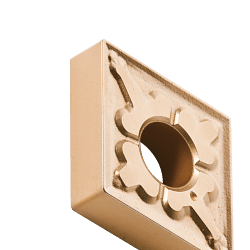< Turning tools Negative and positive turning inserts
Turning inserts, both negative and positive, represent a crucial element in the machining landscape. Although they may seem simple at first glance, these components are the result of continuous innovation and precision engineering that make them indispensable for modern machine shops. Their main function is to ensure efficient and precise machining of materials, helping to improve the quality of the end product and optimise production processes.
The difference between negative and positive inserts
Turning inserts are mainly divided into two categories: negative and positive. This distinction is fundamental to understanding their applications and the advantages they offer.
Negative inserts are characterised by a negative rake angle, which means that the cutting surface is inclined towards the workpiece. This design allows the use of stronger and more robust inserts, ideal for heavy machining and hard materials. Negative inserts offer greater durability and stability, reducing the risk of breakage during turning operations.
On the other hand, positive inserts have a positive rake angle, with the cutting surface inclined away from the workpiece. This design reduces the cutting force required, making them suitable for light machining and softer materials. Positive rake inserts are particularly valued for their ability to produce high quality surface finishes and for their ease of use in applications requiring precision.
Applications and use of turning inserts
Turning inserts are used in a wide range of industrial applications, from the production of automotive components to the manufacture of parts for the aerospace industry. The choice between negative and positive inserts depends on various factors, including the type of material to be machined, project specifications and operating conditions.
For machining operations that require aggressive material removal and wear resistance, negative inserts are the ideal choice. They are commonly used in the machining of hard steels and tough alloys, where strength and durability are essential.
Positive inserts, on the other hand, are preferred for machining requiring precision and high quality finish. They are ideal for softer materials such as aluminium and light alloys, where reducing cutting forces and minimising vibration are crucial to achieving optimum results.
Advantages of turning inserts
The use of turning inserts offers numerous advantages that go beyond mere operational efficiency. One of the main benefits is the possibility to reduce machine downtime due to their easy replacement. Inserts can be quickly changed without the need to remove the tool from the machine, thus improving overall productivity.
In addition, turning inserts contribute to improving the quality of the final product. Due to their precision and ability to maintain close tolerances, they ensure smooth surfaces and accurate dimensions, reducing the need for subsequent machining.
Another significant benefit is the reduction in operating costs. Turning inserts are designed to last a long time and resist wear, which results in less frequent replacement and, consequently, savings in consumable costs.
Frequently asked questions about turning inserts
1. What is the average lifetime of a turning insert?
The life of a turning insert depends on various factors, including the material being machined, cutting conditions and tool maintenance. However, with proper use, inserts can last several hours of continuous machining.
2. How to choose between a negative and a positive insert?
The choice between a negative and a positive insert depends mainly on the type of machining and the material. Negative inserts are ideal for heavy machining and hard materials, while positive inserts are more suitable for light machining and soft materials.
3. Can turning inserts be resharpened?
In general, turning inserts are not designed to be resharpened. Once the insert is worn, it is advisable to replace it to ensure optimum performance.
4. What are the most common materials used for turning inserts?
Turning inserts are made of various materials, including tungsten carbide, ceramic and polycrystalline diamond. The choice of material depends on the specific application and machining requirements.
5. How can the tool life of turning inserts be improved?
To improve the tool life of inserts, it is important to follow the manufacturer's recommendations regarding cutting speeds and feed parameters. Also, proper machine maintenance and the use of appropriate lubricants can help extend the life of the inserts.
Conclusion
Turning inserts, both negative and positive, are essential components for machine shops seeking to optimise their production processes. Their ability to improve end-product quality, reduce downtime and lower operating costs makes them an indispensable choice for any turning operation. Understanding the differences between negative and positive inserts and knowing how best to use them can make the difference between an efficient machining process and one that fails to meet expectations. As production technologies continue to evolve, turning inserts will continue to play a crucial role in the future of machining.
Read More Read Less 

















